As expected from yesterday’s AD line and VIX bearish signals, price moved lower today.
Two support lines are identified on charts today, along with a Fibonacci ratio, to indicate where the pullback may end.
Summary: A short term Elliott wave target is 2,744. A short term classic analysis target is 2,811. At about one of these points a small consolidation or pullback may be expected.
For the short term, volume today suggests this pullback is not over. The target for it to end is still about 2,651, finding support about the upper edge of the Elliott wave triangle trend line.
The long to mid term Elliott wave target is at 2,922, and a classic analysis target is now at 3,045.
Corrections are an opportunity to join the trend.
New all time highs this week, from both the AD line and On Balance Volume, give a high level of confidence to the expectation that price is likely to follow through to new all time highs.
Always practice good risk management. Always trade with stops and invest only 1-5% of equity on any one trade.
New updates to this analysis are in bold.
The biggest picture, Grand Super Cycle analysis, is here.
Last historic analysis with monthly charts is here. Video is here.
An alternate idea at the monthly chart level is given here at the end of this analysis.
An historic example of a cycle degree fifth wave is given at the end of the analysis here.
ELLIOTT WAVE COUNT
WEEKLY CHART
Cycle wave V must complete as a five structure, which should look clear at the weekly chart level. It may only be an impulse or ending diagonal. At this stage, it is clear it is an impulse.
Within cycle wave V, the third waves at all degrees may only subdivide as impulses.
Intermediate wave (4) has breached an Elliott channel drawn using Elliott’s first technique. The channel is redrawn using Elliott’s second technique: the first trend line from the ends of intermediate waves (2) to (4), then a parallel copy on the end of intermediate wave (3). Intermediate wave (5) may end either midway within the channel, or about the upper edge.
Intermediate wave (4) may now be a complete regular contracting triangle lasting fourteen weeks, one longer than a Fibonacci thirteen. There is perfect alternation and excellent proportion between intermediate waves (2) and (4).
If intermediate wave (4) were to continue further as either a flat or combination, both possibilities would require another deep pullback to end at or below 2,532.69. With both On Balance Volume and the AD line making a new all time highs, that possibility looks extremely unlikely.
If intermediate wave (4) were to continue further, it would now be grossly disproportionate to intermediate wave (2). Both classic technical analysis and Elliott wave analysis now suggest these alternate ideas should be discarded based upon a very low probability.
DAILY CHART
It is possible that intermediate wave (4) is a complete regular contracting triangle, the most common type of triangle. Minor wave E may have found support just below the 200 day moving average and ending reasonably short of the A-C trend line. This is the most common look for E waves of triangles.
Intermediate wave (3) exhibits no Fibonacci ratio to intermediate wave (1). It is more likely then that intermediate wave (5) may exhibit a Fibonacci ratio to either of intermediate waves (1) or (3). The most common Fibonacci ratio would be equality in length with intermediate wave (1), but in this instance that would expect a truncation. The next common Fibonacci ratio is used to calculate a target for intermediate wave (5) to end.
Price has clearly broken out above the upper triangle B-D trend line. This indicates that it should now be over if the triangle is correctly labelled.
A resistance line in lilac is added to this chart. It is the same line as the upper edge of the symmetrical triangle on the daily technical analysis chart. Upwards movement has sliced cleanly through this line, finding no resistance before breaking it. This line may offer some support for any pullbacks. Price found support at that line today. A breach of that line does not mean the classic triangle is invalid and that price must make new lows, only that the pullback is deeper. Look for next support at the blue Elliott wave triangle B-D trend line.
Sometimes the point at which the triangle trend lines cross over sees a trend change. A trend change at that point may be a minor one or a major one. That point is now about the 5th of June.
HOURLY CHART
Intermediate wave (5) must subdivide as either an impulse or an ending diagonal. An impulse is much more common and that shall be how this is labelled, until price shows otherwise.
Minor wave 1 is a complete five wave impulse. The middle portion of minuette wave (iii) does not have as good a look for this wave count, but the S&P does not always have good looking impulses.
Minor wave 1 may have lasted seven days. Minor wave 2 may be expected to last about three to eight days to have reasonable proportion to minor wave 1. Targets for minor wave 2 may be the 0.382 and 0.618 Fibonacci ratios, with the 0.618 Fibonacci ratio slightly favoured, which is also where price may find support: at the blue triangle trend line copied over from the daily chart.
Minor wave 2 may be subdividing as a zigzag, and within it minute wave a may be a complete five wave impulse. Minute wave b may continue higher or sideways tomorrow. If minute wave a is correctly labelled as a five, then minute wave b may not move beyond its start above 2,742.10.
It is also possible that minute wave a is incorrectly labelled. It may be a complete double zigzag. If minute wave a is a corrective structure, then minor wave 2 may be unfolding as a flat correction. Within a flat correction, minute wave b may make a new high above the start of minute wave a at 2,742.10 as in an expanded flat. It is for this reason that an upper invalidation point is not added to this hourly chart.
Minor wave 2 may not move beyond the start of minor wave 1 below 2,594.62.
TECHNICAL ANALYSIS
WEEKLY CHART
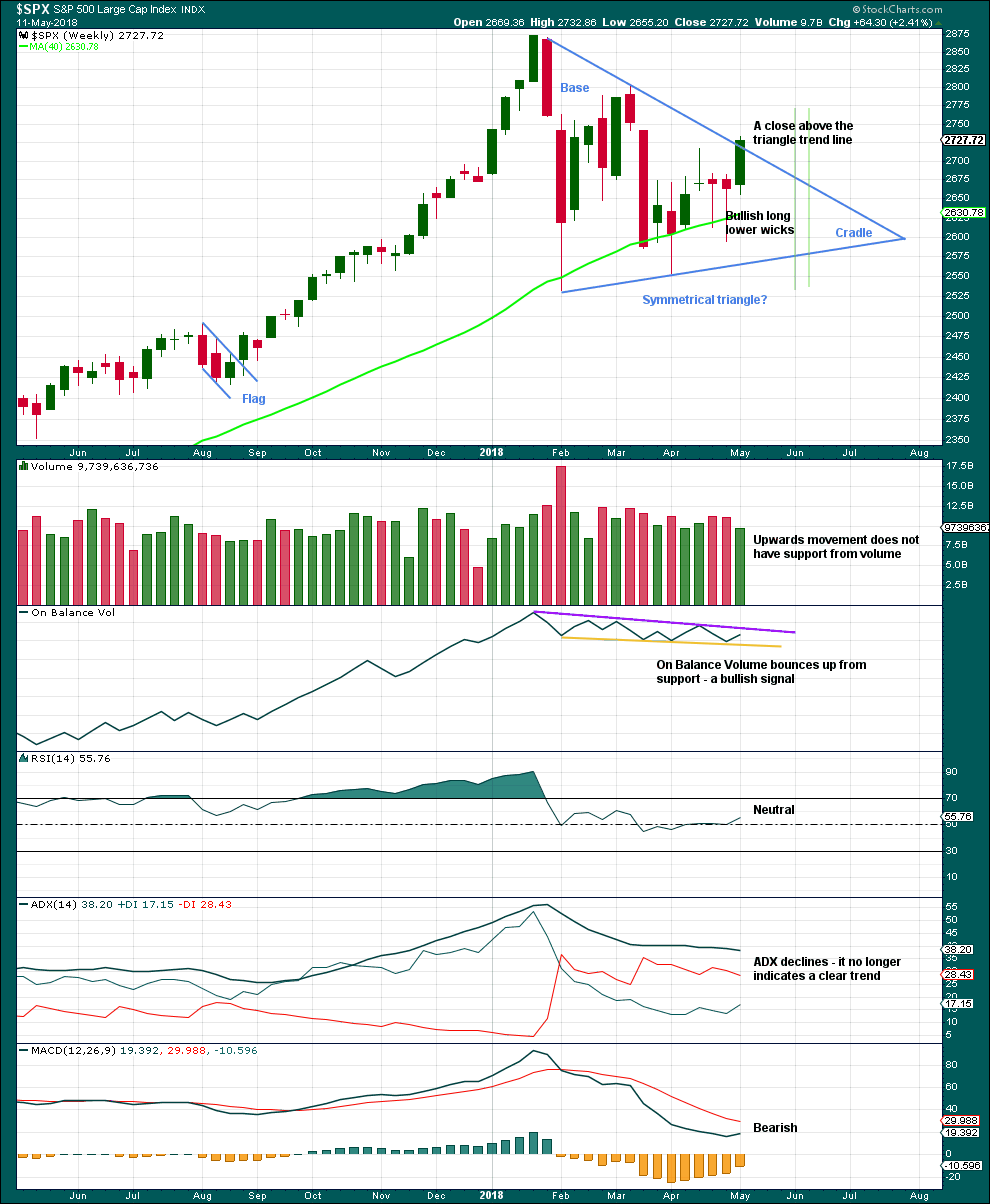
Click chart to enlarge. Chart courtesy of StockCharts.com.
A classic symmetrical triangle pattern may be forming. These are different to Elliott wave triangles. Symmetrical triangles may be either continuation or reversal patterns, while Elliott wave triangles are always continuation patterns and have stricter rules.
The vertical green lines are 73% to 75% of the length of the triangle from cradle to base, where a breakout most commonly occurs.
From Dhalquist and Kirkpatrick on trading triangles:
“The ideal situation for trading triangles is a definite breakout, a high trading range within the triangle, an upward-sloping volume trend during the formation of the triangle, and especially a gap on the breakout.”
For this example, the breakout may have happened last week. There was a high trading range within the triangle, but volume declined.
DAILY CHART
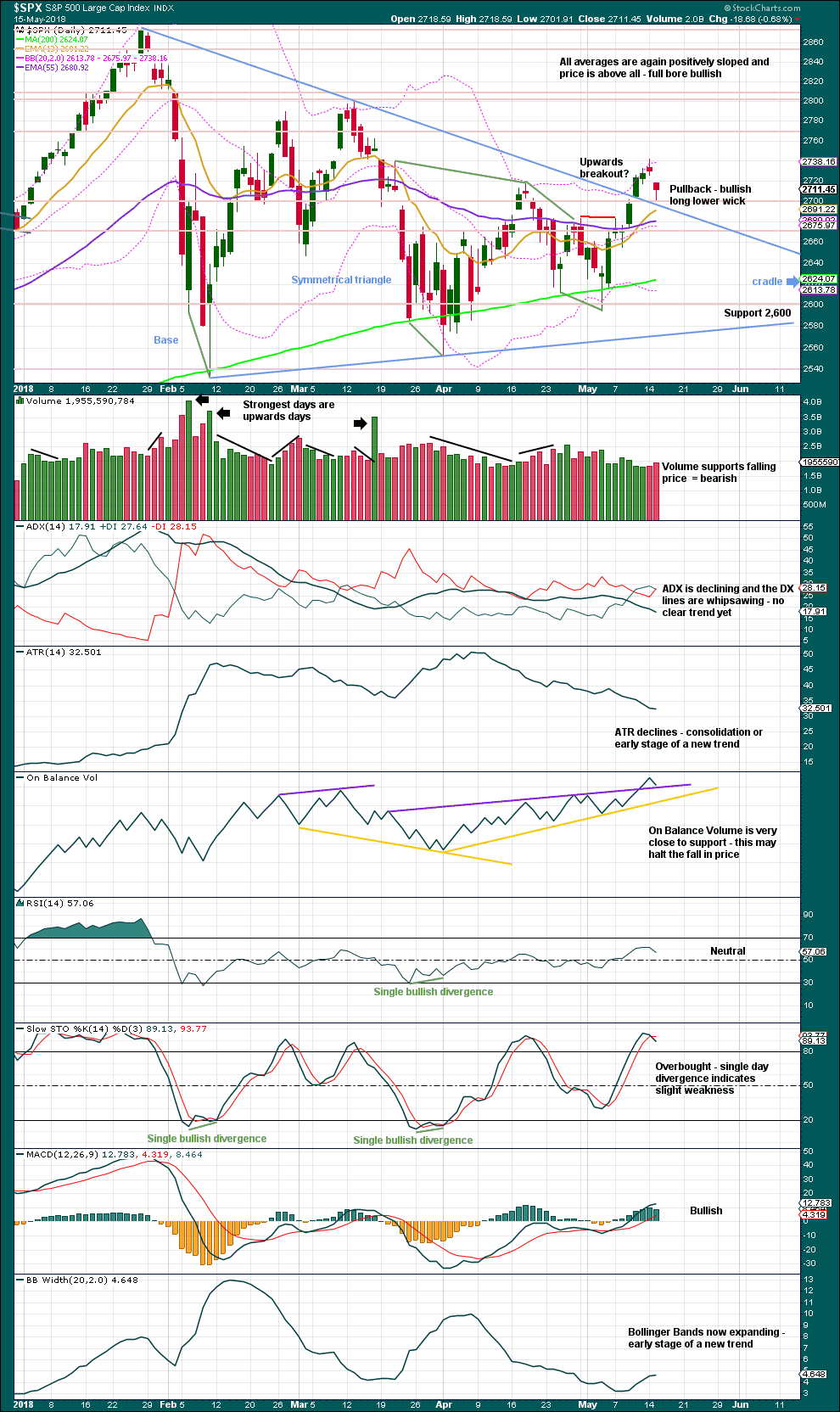
Click chart to enlarge. Chart courtesy of StockCharts.com.
The symmetrical triangle may now be complete, and price has completed an upwards breakout. There may be some small cause for concern that the upwards breakout does not have support from volume. However, in current market conditions only some small concern is had here. Rising price on light and declining volume has been a feature of this market for many months, yet price continues to rise.
After an upwards breakout, pullbacks occur 59% of the time. A pullback may find support at the upper triangle trend line and may be used as an opportunity to join a trend. The trend line sits slightly differently here with StockCharts data than it does on BarChart data used for the Elliott wave analysis. Here, there is a little more room for the pullback to move lower. If price moves lower, then the last gap will be closed and would then be considered a pattern gap and not a measuring gap.
Symmetrical triangles suffer from many false breakouts. If price returns back into the triangle, then the breakout will be considered false and the triangle trend line will be redrawn.
The base distance is 340.18. Added to the breakout point of 2,704.54 this gives a target at 3,044.72. This is above the Elliott wave target at 2,922, so the Elliott wave target may be inadequate.
For the short term, the next smaller consolidation or pullback may come about 2,811. This shorter term target is calculated using the measuring gap. That gap may now provide support and may be used to pull up stops on long positions. The gap remains just open as of today; if it provides support, then tomorrow should not see any downwards movement.
On Balance Volume has made a new all time high, providing a very strong bullish signal; expect price to follow.
Support today from volume suggests downwards movement is not over here.
VOLATILITY – INVERTED VIX CHART
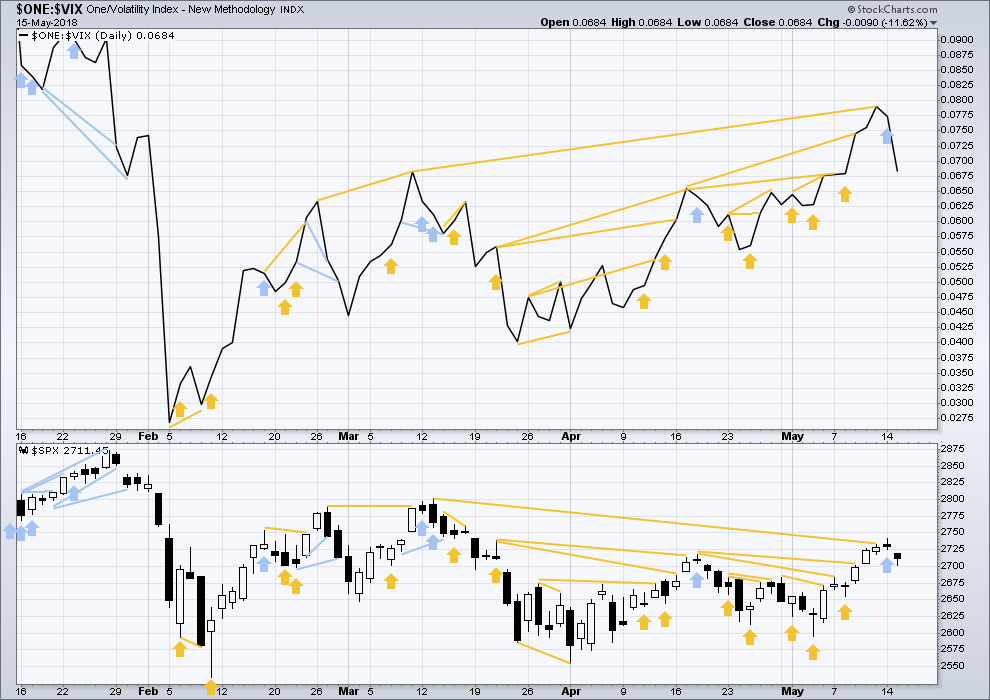
Click chart to enlarge. Chart courtesy of StockCharts.com.
So that colour blind members are included, bearish signals will be noted with blue and bullish signals with yellow.
Normally, volatility should decline as price moves higher and increase as price moves lower. This means that normally inverted VIX should move in the same direction as price.
There is still a cluster of bullish signals on inverted VIX. Overall, this may offer support to the main Elliott wave count.
Inverted VIX is much higher than the prior swing high of the 9th / 13th March, but price is not yet. Reading VIX as a leading indicator, this divergence is bullish.
Bearish divergence noted yesterday has correctly predicted a downwards day. This may be now resolved, or it may need another downwards day to resolve it.
Price moved lower today, with support from rising market volatility, as inverted VIX moved lower.
BREADTH – AD LINE
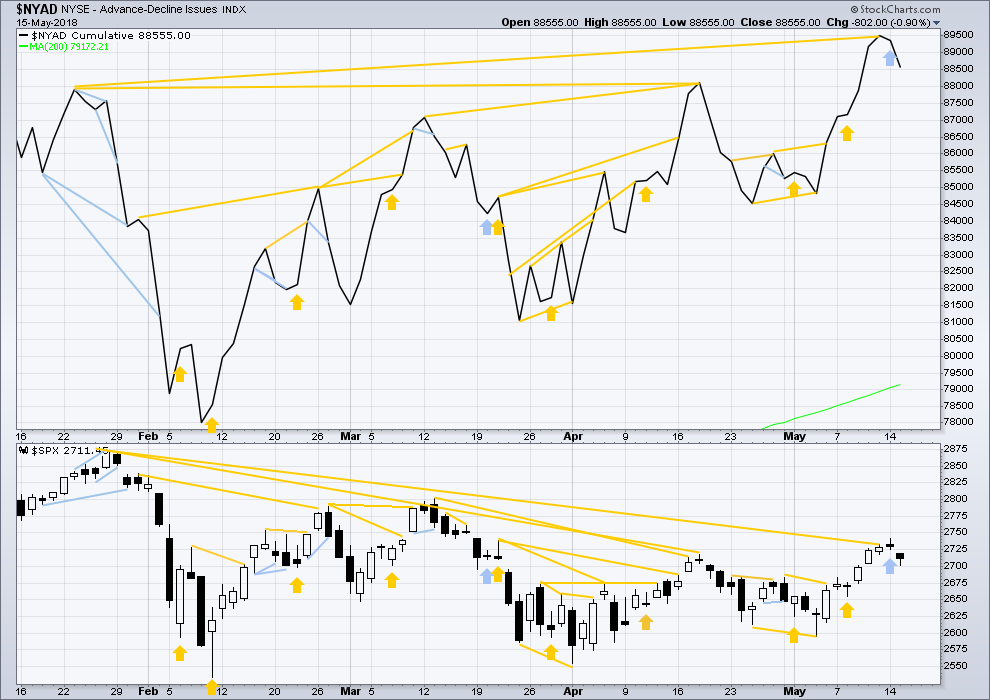
Click chart to enlarge. Chart courtesy of StockCharts.com.
There is normally 4-6 months divergence between price and market breadth prior to a full fledged bear market. This has been so for all major bear markets within the last 90 odd years. With no longer term divergence yet at this point, any decline in price should be expected to be a pullback within an ongoing bull market and not necessarily the start of a bear market. New all time highs from the AD line means that any bear market may now be an absolute minimum of 4 months away. It may of course be a lot longer than that. My next expectation for the end of this bull market may now be October 2019.
Small caps have made a new all time high last week, but mid and large caps have yet to do so. This divergence may be interpreted as bullish. Small caps may now be leading the market.
Breadth should be read as a leading indicator.
There has been a cluster of bullish signals from the AD line in the last few weeks. This also overall offers good support to the main Elliott wave count.
The AD line has made another new all time high. This is a very strong bullish signal, and is one reason why the more bearish Elliott wave counts are discarded. It is extremely likely now that price shall follow with a new all time high.
Bearish divergence noted yesterday has been followed by downwards movement from price. This may now be resolved, or it may need another downwards day to resolve it.
Today’s fall in price has support from declining market breadth. There is no new divergence.
DOW THEORY
The following lows need to be exceeded for Dow Theory to confirm the end of the bull market and a change to a bear market:
DJIA: 23,360.29.
DJT: 9,806.79.
S&P500: 2,532.69.
Nasdaq: 6,630.67.
At this stage, only DJIA has made a new major swing low. DJT also needs to make a new major swing low for Dow Theory to indicate a switch from a bull market to a bear market. For an extended Dow Theory, which includes the S&P500 and Nasdaq, these two markets also need to make new major swing lows.
Charts showing each prior major swing low used for Dow Theory may be seen at the end of this analysis here.
Published @ 09:50 p.m. EST.

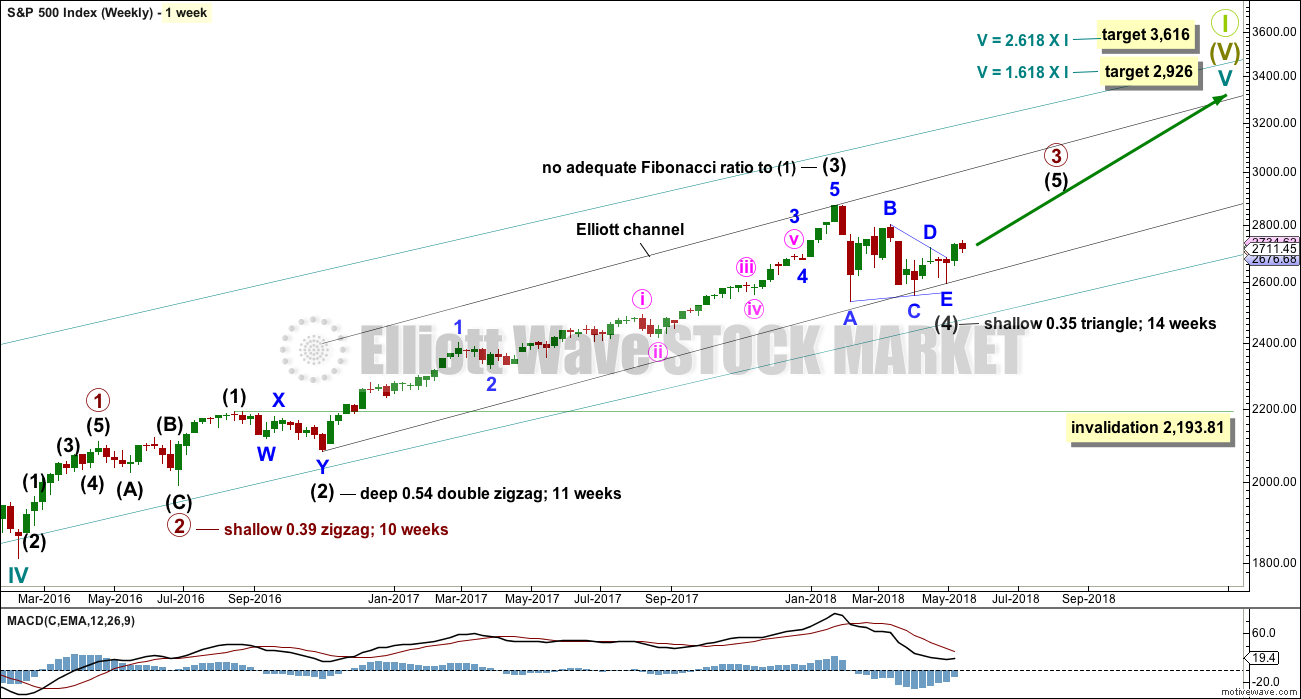
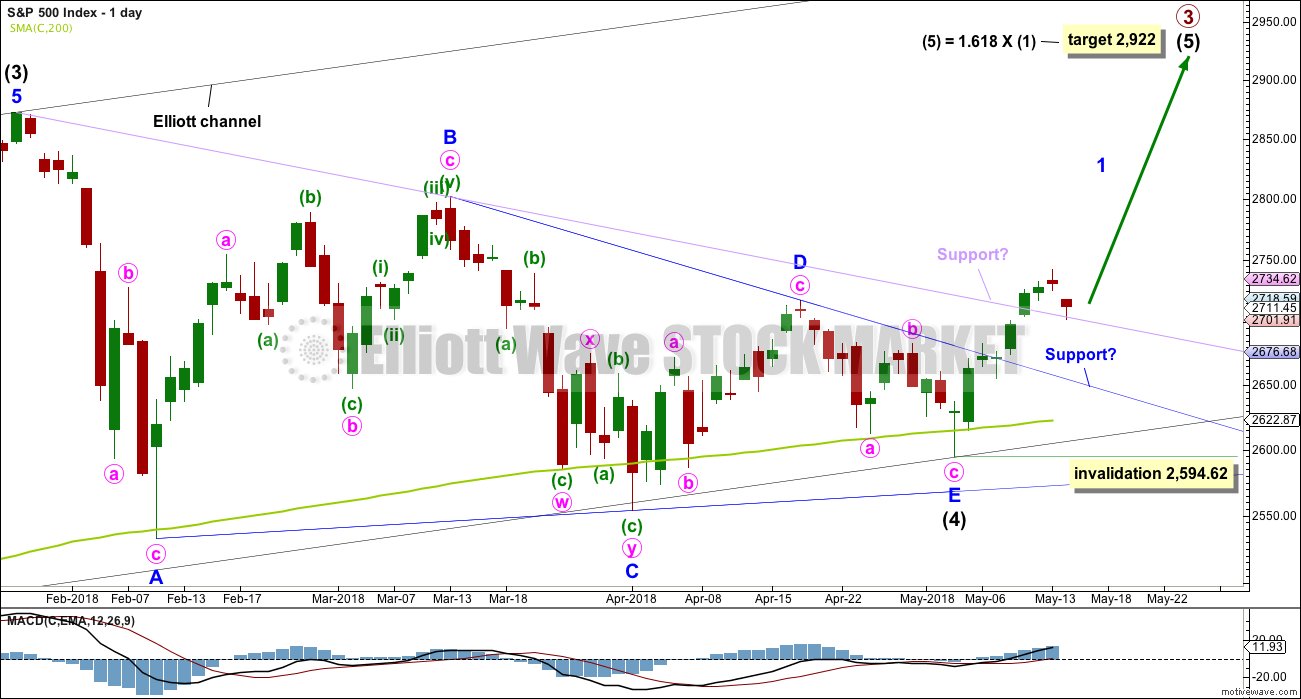
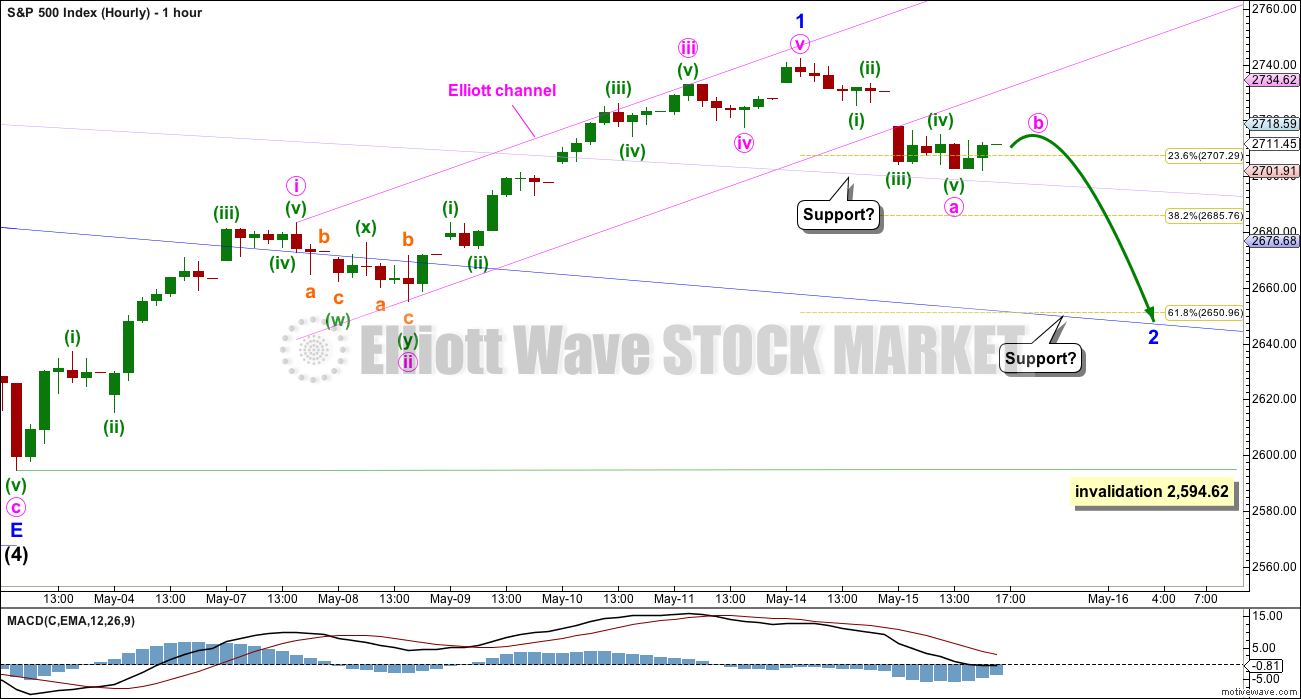
Updated hourly chart:
The 0.382 Fibonacci ratio is also a valid target. About that point minute c would = minute a (at 2,687.95).
“C” you later?
We will “C”…
Everything about the B wave looks “right”, including it’s general weakness. I’ve taken a small short to try to cash on it, but if prices jack back above today’s highs, I’m out, because “that’s not right!”. BTW, I have it on word from my non-EW trading friend that SPY closes at exactly 272.48 today…and he is often really, really accurate with those calls (he made that one 15 minutes into the market session today). So perhaps this C doesn’t start significantly unfolding until tomorrow, perhaps with an opening gap down and then a tumble.
I’m not confident enough yet to jump in this near the close. I might end up wishing I had, but not gonna do it…
FWIW, there is a lot of chatter about yesterday drop blamed on 10 year yield breaking to a new multi-year high. There are a few that are on record saying that this messed up a bunch of technical analysis including EW.
Rising IR’s were probably a factor in yesterday’s movement down.
As for “breaking elliott wave”, only uneducated people re: EW (that would probably be most market pundits, IMO) would say such a thing. No surprise that kind of thing would be in the market chatter. Most pundits view EW as a mystical art, or simply “gobblygook”, as one trader I know calls it.
EW does tend to be more unpopular in bull markets. And at the end of a bull market, very unpopular indeed.
Sadly.
Find the trend, trade the trend. EW bringing probabilities of a downward short term trend may upset anyone in a long position, but then why not trade the downward short term trend. Problem solved for all the haters of EW 🙂
“Small caps may now be leading the market.”
The Russell 2000 just made a new all time high.
yep…this broadening pattern makes me think of an ending diagonal….
Just for fun — PE for Russell is approx. 89 now
I’ve been (very slowly!) reading through some of Precter’s “Beautiful Pictures”. He argues (shows) how often the market doesn’t it exactly phi (.618) and it’s square root ratios, but instead “nearby approximations” based on specific factions. He gets down and dirty on the details, and ends up arguing that for example the .618 area really is from .600 to .667, and the .382 is from 36% to 40%. So I’m experimenting with fibo lines that have the specific “alternative” lines in there, as a kind of “cluster”. When you have two projections (i.e, one peak down to two different swing lows), you end up with a mess…but it’s an informative mess that shows the “zones” of resistance/support rather well. Here’s SPX on the 5 minute showing the result for the current downward action, using two retracement sets. I’ve only done the clustering thing on the .618 and .382, not the other fibos (or it’d be too much).
Nice. I’ve noticed that too. That corrections rarely end right at the 0.618 or 0.382 Fibonacci ratios. They often end very close to them, but not right on them.
Someone asked for my take on the NDX count the other day, here it is. Remember, this is amateur work, nothing like the comprehensive and more informed work Lara provides!
I think you count is right on. It is always interesting to compare and contrast the EW counts of the various indices. Sometimes they align perfectly. At other times, they are a bit out of sync. It is especially helpful, I think, when trying to decide between a multitude of alternates or looking for confirmation of counts.
In this case, NDX would seem to indicate that the completion of Minor 1 of Intermediate 5 on the SPX is still to come. Thus the current correction would be a 4th wave. If so, it would tend to be relatively shallow and I will not make the purchase of the second half of my long positions. I would wait patiently for the end of Minor 2 still to come.
thx….im wondering if this is what the RUT is up to….we are seeing this broadening pattern (megaphone) and wondering, just wondering if we are in an ending diagonal….inputs appreciated!
I suspec the large coil in the RUT is, like it is in the NDX and SPX, an intermediate 4, and like SPX, it probably finished at the low in early May. So what’s going on now is the start of a motive wave up. Which is in a large minor 1, and is currently in minute v of that minor 1, per my chart. I don’t really see any “broadening pattern”. The minor 1 could complete at any moment (it has met all required criteria), and a minor 2 down could start up anytime. That said, it’s reasonable to expect more from the minute 5 up that the small rise so far. RUT is clearly the leader, which fundamentally I attribute to the index being US corp. focused, and the massive incremental earnings due to the tax cuts. I could be way off base on any or all of this.
Thx! It matches mine too. Im also tracking one where we ended the correction intermediate 4 at the 6325 low as a flat….
Lets see how things play out! Thx for sharing
Looks pretty good overall Kevin.
I’d make some changes though to how you’ve labelled minute ii:
Pull minuette (a) over to the left, the first swing low in that first wave down. Now that makes minuette (b) an expanded flat. The subdivisions look really good for that.
Minuette (b) can’t be over quite there, pull it over to the right slightly, four bars along. It has to end at that high, because within minuette (c) it’s second wave can’t move beyond the start of it’s first wave.
Now subminuette c of minuette (b) is a nice five up. And minuette (c) is a straight wave down which may be an impulse.
Got it. You are too kind Lara. Thanks. “Learnin’ at the master’s knee, I am!”.
Notice that the current hourly chart shows the greatest momentum (MACD) of Minor 1 occurring during minute iii. This is in line with EW thinking and supports this count.
and…beware the B wave!!! It just looks “so bullish!!”…..
Should we look for B to close yesterday’s gap and then C down?
It’s hard (impossible?) to know where this B wave stops and turns, I’m afraid. Unless you attempt to count it at the 5 minute level, and then it’s subject to an awful lot of subjectivity. As Lara noted, this could be a flat (or expanding flat) correction, in which case, price could even exceed the higher of 2 days ago, and THEN the C down fires off. It’s tricky. On the other side, it can be 100% discounted that the minor 2 is over and price will just keep moving up here, but it’s unlikely because almost every time I question Lara’s count like that…I’m wrong.
That’s how I see it too, Peter — at the moment. If so, the next C down should hopefully be big enough to grab a piece of it.
Lara,
Kevin suggested that maybe…just maybe, yesterday drop could have been an expanded flat for wave 4 and that minor 1 is not complete yet? …what do think of that?
The problem here for the S&P is the proportions would look wrong with that idea. Minute wave ii lasted 8 hours. So far minute iv has lasted 20 hours, and it would be incomplete.
The idea is technically valid for sure, but it does not have the right look IMO.
When this correction is done if it remains above minute i price territory I’ll chart it again and keep it in mind. If it looks believable then I’ll publish it.
Thanks for the answer Lara! Im learning a lot from the site!
Thanks Lara. I have a question. You wrote:
——————————————————————————-
“Symmetrical triangles suffer from many false breakouts. If price returns back into the triangle, then the breakout will be considered false and the triangle trend line will be redrawn.”
——————————————————————————-
If the triangle trend line is redrawn, would the most recent swing high of 2742.10 be relabeled as Minor D of Intermediate 4?
OT – My trading plan, outlined last week, included buying 50% of my long position on a breakout of the triangle. I did that last week. Part II was to buy the other half of my long position on a return to and test of the upper triangle trend line along with a completion of Minor 2 of Intermediate 5. I am looking to complete that this week or early next week near 2650.
On my SPX daily, I don’t see the triangle line as breached yet. Touched, slightly penetrated, but not breached. In fact it looks to me like a fairly perfect retest…so far. If a C down comes along, maybe it doesn’t last. Breached is probably a full daily bar underneath the trend line?
Rodney, i love your Trading Plan…! Hope it’s not copyrighted! Hehe
May take a few lines from it
Be my guest, Jules. Nothing I write is copyrighted or trademarked. But I suppose all my good ideas come from others. Use at your own discretion.